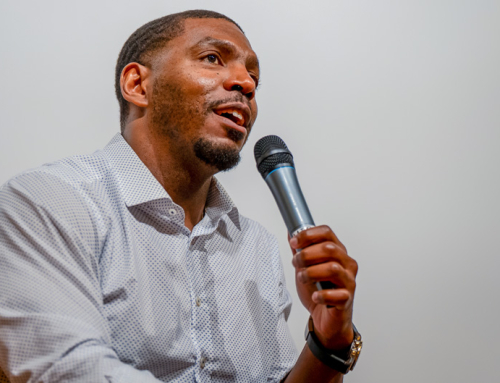By: Barbara Gutierrez
University collaborations, one in Mexico and the other in Brazil, show that many reporters turn to colleagues and their desire to provide public service to bolster emotional strength when facing threat and harassment.
Violence is on the uptick against journalists in Latin America and around the world, as is risk to their emotional well-being during coverage of traumatic events, but little is known about how journalists are coping.
Two new University of Miami studies, in collaboration with academic partners in Mexico and Brazil, revealed that journalists respond in ways that may enhance or reduce their professional mission and emotional well-being, depending upon the type of risk and their options for support.
“We wanted to understand risks to journalists in their own terms, how do they make sense of their experience and how do they deal with it,” said Laura Iesue, a sociology doctoral candidate who began the work with Sallie Hughes while a Distinguished Graduate Fellow at the University’s Institute for Advanced Study of the Americas (UMIA).
While journalists in Mexico and Brazil face frequent risks of physical and emotional harm, some of their experiences are shared by journalists in the global north. For example, journalists in the United States also experience stress when harassed online and while covering events related to great suffering, such as the Surfside condo collapse. Gender-based violence targeting female and LGBTQ+ journalists has been noted in all three countries, as well.
The studies, called “Risk, Victimization and Coping Strategies of Journalists in Mexico and Brazil” and “Coping with Occupational Stress in Journalism: Professional Identities and Advocacy as Resources,” were written by Iesue and Hughes, professor in the School of Communication and faculty lead at UMIA.
The two authors were joined by colleagues in Mexico and Brazil. Mexican colleagues were Hilda Fernández de Ortega and Judith Cruz at The University of the Americas Puebla, and José Carlos Lozano from Monterrey Tec. The Brazilian colleagues were Sonia Virginia Moreira from the State University of Rio de Janeiro and Monica Sousa, Moreira’s former student and now post-doctoral researcher at the Universidad Veiga de Almeida, also in Rio de Janeiro.
Based upon fieldwork conducted between 2018 and 2019, the studies were recently published in the peer-reviewed journals, Journalism Studies and Sur le Jornalisme/About Journalism. The first study focuses on Puebla state in central Mexico, Tamaulipas state on the U.S. border, and Mexico City, the country’s capital. These three areas were chosen because of the varied risks journalists face. The second study compares the experiences of journalists in Puebla and Tamaulipas with similar states in Brazil—the border state of Acre and the interior state of Minas Gerais. Very few studies of this kind have ever been conducted in Brazil, according to Iesue. While a great deal is known about risk in Mexico, less is known about how Mexican journalists cope with risk.
The studies are based upon anonymous, online questionnaires that were distributed in a snowball sample to journalists via Qualtrics software. Many of the questions were open-ended, so that the journalists could elaborate on their answers based upon their experiences. The research used response data from 35 Mexican journalists in the first study and 21 Mexican and 33 Brazilian journalists in the second.
By far, the most prevalent stressor, according to the studies, had to do with failures to uphold the law.
In areas of high crime governed by criminal organizations, reporters were threatened at gunpoint by armed men who asked them to leave the scene of a story they were covering.
Yet others received verbal threats like “I know where you live” or “I know you have a child,” said Iesue. Others were threatened via email and Twitter.
Being a victim of targeted violence or working in dangerous conditions has led journalists to self-censor their work by leaving out sensitive information and avoiding topics about government corruption, abuses of power, and relations with criminal organizations, said the study.
“Self-censorship is a big part of their lives,” said Iesue.
One respondent said her newsroom in Tamaulipas, Mexico, was attacked by gunmen with grenades and gunfire. Some respondents reported stress at covering “the suffering of others” or covering tragedies, said Hughes.
One similarity between the two Latin American countries was that journalists outside of major cities and in border regions of both countries are most vulnerable, Hughes noted.
“In border areas trafficking and smuggling of all kinds occurs with lack of government capacity to respond or sometimes complicity,” she said. “In smaller cities within both countries, journalists lack strong constitutional protections and organizational support, compared to those who work in large cities with major news organizations.”
Another key stressor affecting journalists are political players—politicians and people in social power—who exert their hold over a newsroom or certain journalists by threatening to pull their advertising if a story is not canceled.
One recurring theme in the studies was the harassment against female reporters. Some of the harassment came from within the women’s news organizations, said Hughes.
One woman said she feared being sexually assaulted when an army officer would not let her leave a scene and kept asking for her telephone number. She finally gave him her number and then blocked him.
These stressors are added to the daily ones in journalism where changes in the industry have forced many newsrooms to downsize and, in many cases, require more work from those left behind. Some of the respondents reported an increase in work hours that sometimes were not compensated.
The study asked how journalists coped with daily work stressors. While some coping strategies could be applied to any stressful job, such as exercise or writing poetry, others are unique to journalism.
Self-censorship or moving to a different coverage topic meant that threats did silence important information. Other approaches allowed journalists to continue to report on important but dangerous topics by working in teams or taking greater safety precautions.
In Mexico’s Puebla state, journalists banded together to advocate for greater protections, which they described as work that gave them emotional fortitude.
In both countries, many of the respondents derived comfort from talking to other journalists and reminding themselves that their work was important in a democratic society.
Hughes said the project is an example of some of the interdisciplinary work that the Institute for Advanced Study of the Americas, under the leadership of its director Felicia Knaul, has facilitated in recent years—in this case, involving the School of Communication and the College of Arts and Sciences.
“Collaborative, interdisciplinary work provides a much more holistic understanding of social problems, which in turn leads to better recommendations for policymakers and activists,” said Hughes. “This is the sort of work the institute has supported and continues to facilitate. While the research is based in Latin America, these studies are examples of how research collaborations there provide lessons for the rest of the world.”






